Edublog: Assessing Attitudes with Implicit Association Tests
VerifiedAdded on 2022/09/09
|13
|2762
|25
Essay
AI Summary
This Edublog delves into the realm of Implicit Association Tests (IATs) as tools for assessing attitudes, targeting a general audience. It begins by introducing IATs and their function in measuring implicit biases, referencing the work of Greenwald, McGhee, and Schwartz (1998) and the Project Implicit platform. The blog then explores the psychological underpinnings of attitude formation, including the influence of social and cognitive factors such as groupthink and cognitive dissonance, drawing on the research of Festinger (1954) and others. It examines how these factors can modulate individual attitudes and potentially impact IAT results. The blog further analyzes the relationship between attitudes, implicit behaviors, and explicit behaviors, referencing the work of Cooper, Blackman, and Keller (2016). It critically evaluates the accuracy and appropriateness of IATs, considering potential limitations like semantic satiation and the algorithmic nature of result evaluation. The Edublog concludes with a discussion of the reliability of IATs and their potential implications, providing an evidence-based perspective on whether this practice should be rolled out across the whole country.

Running head: EDUBLOG
EDUBLOG
Name of the Student
Name of the University
Author note
EDUBLOG
Name of the Student
Name of the University
Author note
Paraphrase This Document
Need a fresh take? Get an instant paraphrase of this document with our AI Paraphraser

1EDUBLOG
Contents
Background................................................................................................................................2
What are IATs............................................................................................................................3
IATs and personal belief system: Modulating factors...............................................................4
Attitudes and implicit behaviours..............................................................................................5
IAT – Evaluation of accuracy and appropriateness...................................................................7
Takeaway.................................................................................................................................10
References................................................................................................................................11
Contents
Background................................................................................................................................2
What are IATs............................................................................................................................3
IATs and personal belief system: Modulating factors...............................................................4
Attitudes and implicit behaviours..............................................................................................5
IAT – Evaluation of accuracy and appropriateness...................................................................7
Takeaway.................................................................................................................................10
References................................................................................................................................11
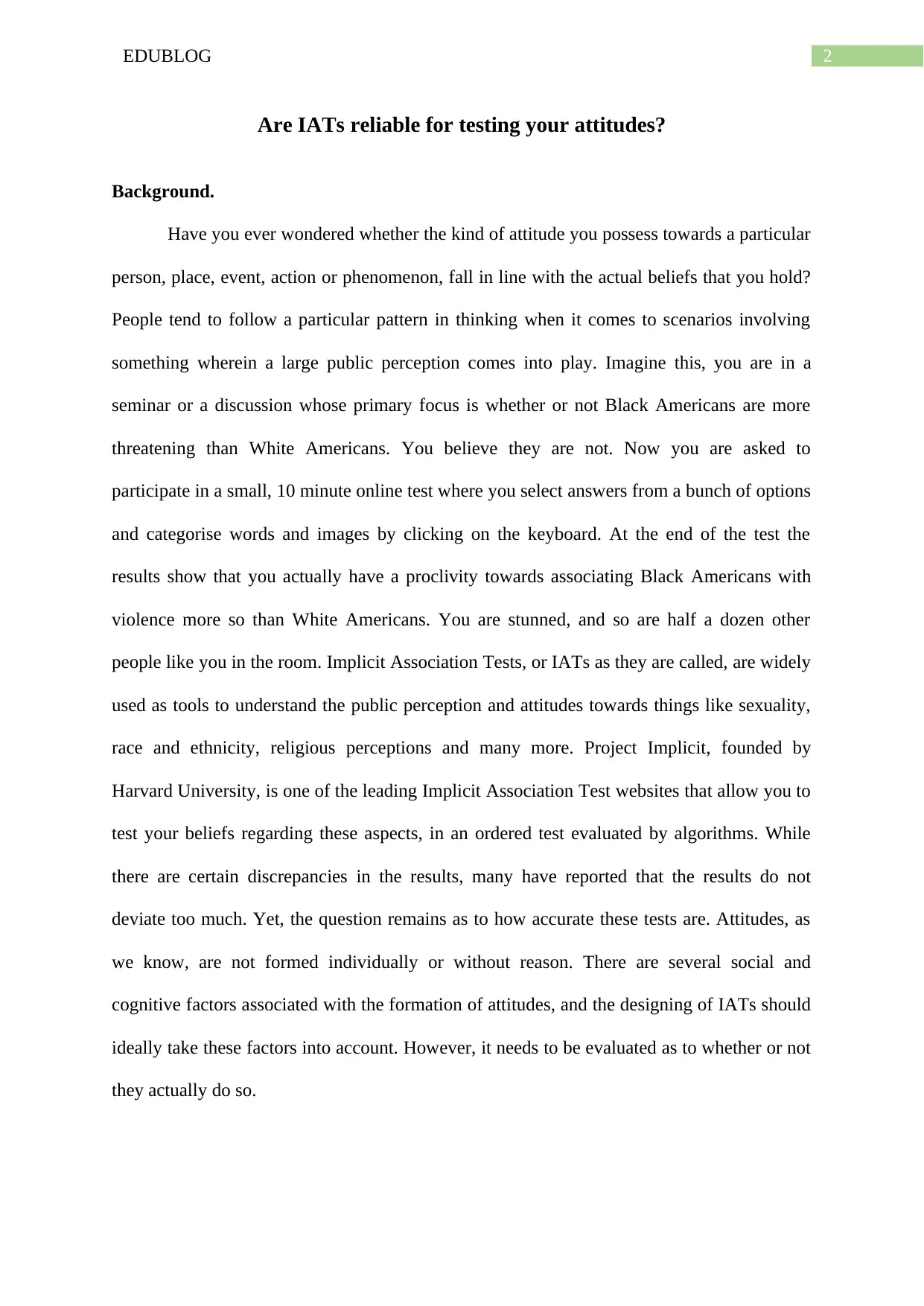
2EDUBLOG
Are IATs reliable for testing your attitudes?
Background.
Have you ever wondered whether the kind of attitude you possess towards a particular
person, place, event, action or phenomenon, fall in line with the actual beliefs that you hold?
People tend to follow a particular pattern in thinking when it comes to scenarios involving
something wherein a large public perception comes into play. Imagine this, you are in a
seminar or a discussion whose primary focus is whether or not Black Americans are more
threatening than White Americans. You believe they are not. Now you are asked to
participate in a small, 10 minute online test where you select answers from a bunch of options
and categorise words and images by clicking on the keyboard. At the end of the test the
results show that you actually have a proclivity towards associating Black Americans with
violence more so than White Americans. You are stunned, and so are half a dozen other
people like you in the room. Implicit Association Tests, or IATs as they are called, are widely
used as tools to understand the public perception and attitudes towards things like sexuality,
race and ethnicity, religious perceptions and many more. Project Implicit, founded by
Harvard University, is one of the leading Implicit Association Test websites that allow you to
test your beliefs regarding these aspects, in an ordered test evaluated by algorithms. While
there are certain discrepancies in the results, many have reported that the results do not
deviate too much. Yet, the question remains as to how accurate these tests are. Attitudes, as
we know, are not formed individually or without reason. There are several social and
cognitive factors associated with the formation of attitudes, and the designing of IATs should
ideally take these factors into account. However, it needs to be evaluated as to whether or not
they actually do so.
Are IATs reliable for testing your attitudes?
Background.
Have you ever wondered whether the kind of attitude you possess towards a particular
person, place, event, action or phenomenon, fall in line with the actual beliefs that you hold?
People tend to follow a particular pattern in thinking when it comes to scenarios involving
something wherein a large public perception comes into play. Imagine this, you are in a
seminar or a discussion whose primary focus is whether or not Black Americans are more
threatening than White Americans. You believe they are not. Now you are asked to
participate in a small, 10 minute online test where you select answers from a bunch of options
and categorise words and images by clicking on the keyboard. At the end of the test the
results show that you actually have a proclivity towards associating Black Americans with
violence more so than White Americans. You are stunned, and so are half a dozen other
people like you in the room. Implicit Association Tests, or IATs as they are called, are widely
used as tools to understand the public perception and attitudes towards things like sexuality,
race and ethnicity, religious perceptions and many more. Project Implicit, founded by
Harvard University, is one of the leading Implicit Association Test websites that allow you to
test your beliefs regarding these aspects, in an ordered test evaluated by algorithms. While
there are certain discrepancies in the results, many have reported that the results do not
deviate too much. Yet, the question remains as to how accurate these tests are. Attitudes, as
we know, are not formed individually or without reason. There are several social and
cognitive factors associated with the formation of attitudes, and the designing of IATs should
ideally take these factors into account. However, it needs to be evaluated as to whether or not
they actually do so.
⊘ This is a preview!⊘
Do you want full access?
Subscribe today to unlock all pages.

Trusted by 1+ million students worldwide
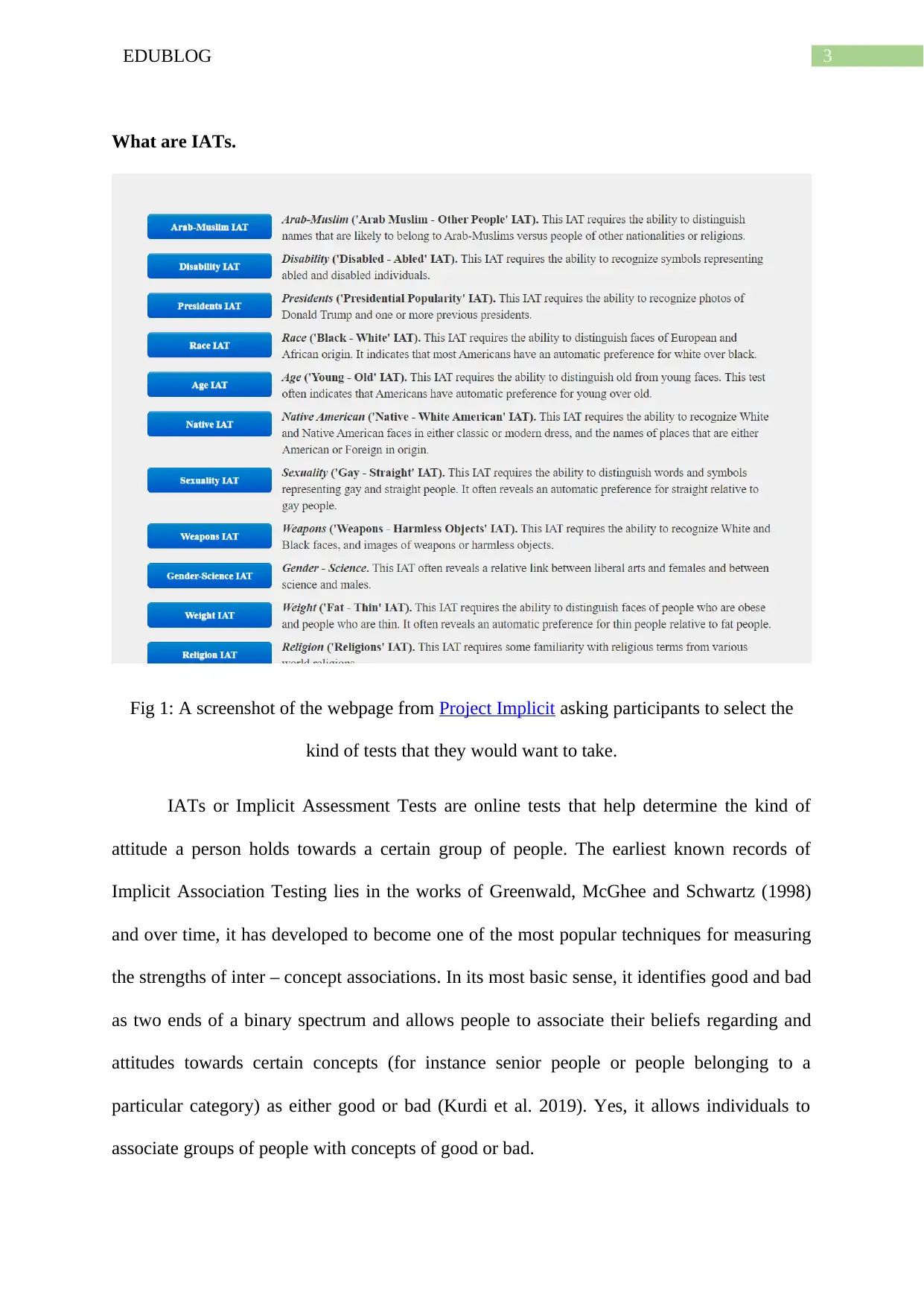
3EDUBLOG
What are IATs.
Fig 1: A screenshot of the webpage from Project Implicit asking participants to select the
kind of tests that they would want to take.
IATs or Implicit Assessment Tests are online tests that help determine the kind of
attitude a person holds towards a certain group of people. The earliest known records of
Implicit Association Testing lies in the works of Greenwald, McGhee and Schwartz (1998)
and over time, it has developed to become one of the most popular techniques for measuring
the strengths of inter – concept associations. In its most basic sense, it identifies good and bad
as two ends of a binary spectrum and allows people to associate their beliefs regarding and
attitudes towards certain concepts (for instance senior people or people belonging to a
particular category) as either good or bad (Kurdi et al. 2019). Yes, it allows individuals to
associate groups of people with concepts of good or bad.
What are IATs.
Fig 1: A screenshot of the webpage from Project Implicit asking participants to select the
kind of tests that they would want to take.
IATs or Implicit Assessment Tests are online tests that help determine the kind of
attitude a person holds towards a certain group of people. The earliest known records of
Implicit Association Testing lies in the works of Greenwald, McGhee and Schwartz (1998)
and over time, it has developed to become one of the most popular techniques for measuring
the strengths of inter – concept associations. In its most basic sense, it identifies good and bad
as two ends of a binary spectrum and allows people to associate their beliefs regarding and
attitudes towards certain concepts (for instance senior people or people belonging to a
particular category) as either good or bad (Kurdi et al. 2019). Yes, it allows individuals to
associate groups of people with concepts of good or bad.
Paraphrase This Document
Need a fresh take? Get an instant paraphrase of this document with our AI Paraphraser

4EDUBLOG
IATs and personal belief system: Modulating factors.
As mentioned earlier, a lot of personal beliefs and attitudes are shaped by the ways a
person attempts to ‘fit in’ with a particular group. It means, that if you hang out with a group
of people who identify homosexual people as bad, and if that group is the core group amongst
all your social circles, there are chances that you will reshape your opinions and beliefs
regarding homosexual people just so you can comply with the group beliefs. In social
psychology, this phenomenon can be identified under concepts of social cohesion and
groupthink. Leon Festigner studied the impact of social cohesiveness on the behavioural
shaping of individuals almost sixty years ago, and found that social comparison and
formation of opinions are connected more intricately that what is usually perceived (Festigner
1954). Thus the perception of a particular category of people by the social group that an
individual is a part of, plays a vital role in modulating the kind of perceptions that the
individual would hold towards the category.
A cognitive dissonance is identified as the state of having inconsistent thoughts and
changing attitudes and beliefs, especially as a product of behavioural decisions. Dusso (2017)
studied cognitive dissonance in people and found that it occurs when individuals are asked to
evaluate their own ideologies. He further argues that the aspect of cognitive dissonance also
driven partially by the type of personality that individual possesses, particularly the level of
agreeableness (Dusso, 2017). Connecting this aspect to what Festigner studied, we can assert
that people have a tendency of trying to be agreeable and establish positive relationships.
Conforming to groupthink usually comes as an effect of that desire and leads to cognitive
dissonance. But how does that connect to individual attitudes and IATs? Well, imagine a
scenario where you are out with a group of 10 friends. Nine out of the ten people think that
immigrants are the prime cause behind loss of employability in a host nation. You are the odd
one out. If you try to be accepted in that group and establish yourself as a part of the
IATs and personal belief system: Modulating factors.
As mentioned earlier, a lot of personal beliefs and attitudes are shaped by the ways a
person attempts to ‘fit in’ with a particular group. It means, that if you hang out with a group
of people who identify homosexual people as bad, and if that group is the core group amongst
all your social circles, there are chances that you will reshape your opinions and beliefs
regarding homosexual people just so you can comply with the group beliefs. In social
psychology, this phenomenon can be identified under concepts of social cohesion and
groupthink. Leon Festigner studied the impact of social cohesiveness on the behavioural
shaping of individuals almost sixty years ago, and found that social comparison and
formation of opinions are connected more intricately that what is usually perceived (Festigner
1954). Thus the perception of a particular category of people by the social group that an
individual is a part of, plays a vital role in modulating the kind of perceptions that the
individual would hold towards the category.
A cognitive dissonance is identified as the state of having inconsistent thoughts and
changing attitudes and beliefs, especially as a product of behavioural decisions. Dusso (2017)
studied cognitive dissonance in people and found that it occurs when individuals are asked to
evaluate their own ideologies. He further argues that the aspect of cognitive dissonance also
driven partially by the type of personality that individual possesses, particularly the level of
agreeableness (Dusso, 2017). Connecting this aspect to what Festigner studied, we can assert
that people have a tendency of trying to be agreeable and establish positive relationships.
Conforming to groupthink usually comes as an effect of that desire and leads to cognitive
dissonance. But how does that connect to individual attitudes and IATs? Well, imagine a
scenario where you are out with a group of 10 friends. Nine out of the ten people think that
immigrants are the prime cause behind loss of employability in a host nation. You are the odd
one out. If you try to be accepted in that group and establish yourself as a part of the
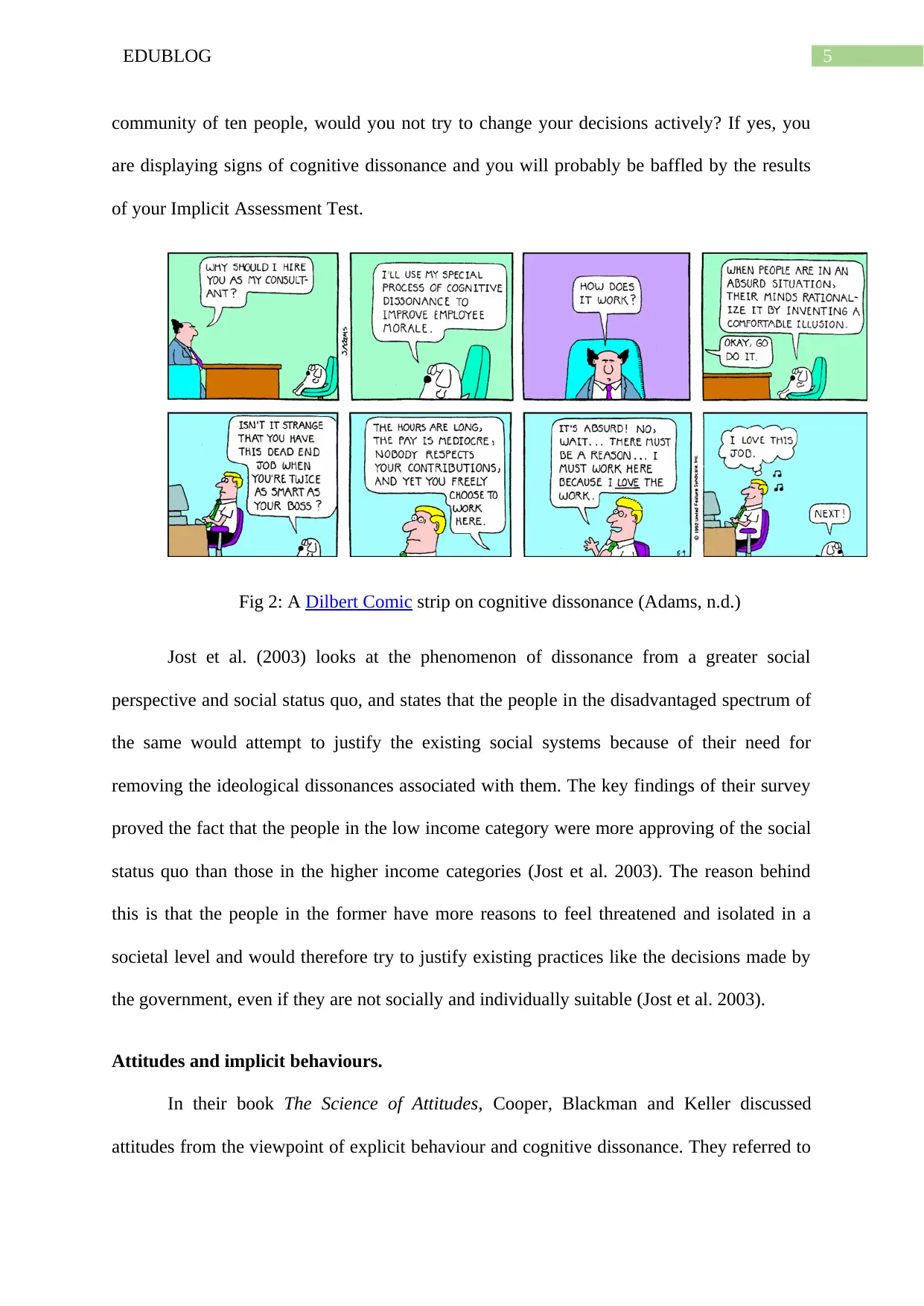
5EDUBLOG
community of ten people, would you not try to change your decisions actively? If yes, you
are displaying signs of cognitive dissonance and you will probably be baffled by the results
of your Implicit Assessment Test.
Fig 2: A Dilbert Comic strip on cognitive dissonance (Adams, n.d.)
Jost et al. (2003) looks at the phenomenon of dissonance from a greater social
perspective and social status quo, and states that the people in the disadvantaged spectrum of
the same would attempt to justify the existing social systems because of their need for
removing the ideological dissonances associated with them. The key findings of their survey
proved the fact that the people in the low income category were more approving of the social
status quo than those in the higher income categories (Jost et al. 2003). The reason behind
this is that the people in the former have more reasons to feel threatened and isolated in a
societal level and would therefore try to justify existing practices like the decisions made by
the government, even if they are not socially and individually suitable (Jost et al. 2003).
Attitudes and implicit behaviours.
In their book The Science of Attitudes, Cooper, Blackman and Keller discussed
attitudes from the viewpoint of explicit behaviour and cognitive dissonance. They referred to
community of ten people, would you not try to change your decisions actively? If yes, you
are displaying signs of cognitive dissonance and you will probably be baffled by the results
of your Implicit Assessment Test.
Fig 2: A Dilbert Comic strip on cognitive dissonance (Adams, n.d.)
Jost et al. (2003) looks at the phenomenon of dissonance from a greater social
perspective and social status quo, and states that the people in the disadvantaged spectrum of
the same would attempt to justify the existing social systems because of their need for
removing the ideological dissonances associated with them. The key findings of their survey
proved the fact that the people in the low income category were more approving of the social
status quo than those in the higher income categories (Jost et al. 2003). The reason behind
this is that the people in the former have more reasons to feel threatened and isolated in a
societal level and would therefore try to justify existing practices like the decisions made by
the government, even if they are not socially and individually suitable (Jost et al. 2003).
Attitudes and implicit behaviours.
In their book The Science of Attitudes, Cooper, Blackman and Keller discussed
attitudes from the viewpoint of explicit behaviour and cognitive dissonance. They referred to
⊘ This is a preview!⊘
Do you want full access?
Subscribe today to unlock all pages.

Trusted by 1+ million students worldwide
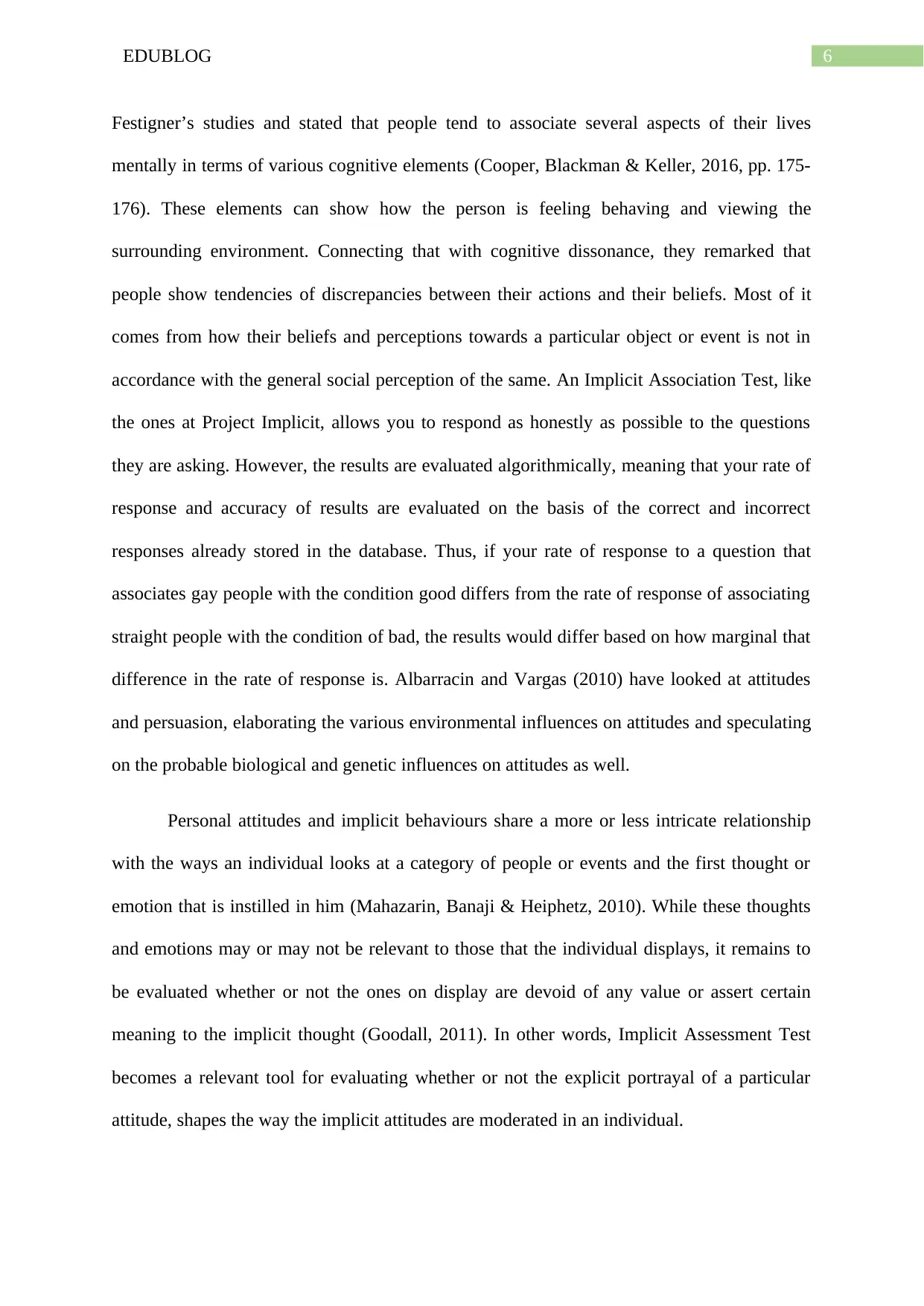
6EDUBLOG
Festigner’s studies and stated that people tend to associate several aspects of their lives
mentally in terms of various cognitive elements (Cooper, Blackman & Keller, 2016, pp. 175-
176). These elements can show how the person is feeling behaving and viewing the
surrounding environment. Connecting that with cognitive dissonance, they remarked that
people show tendencies of discrepancies between their actions and their beliefs. Most of it
comes from how their beliefs and perceptions towards a particular object or event is not in
accordance with the general social perception of the same. An Implicit Association Test, like
the ones at Project Implicit, allows you to respond as honestly as possible to the questions
they are asking. However, the results are evaluated algorithmically, meaning that your rate of
response and accuracy of results are evaluated on the basis of the correct and incorrect
responses already stored in the database. Thus, if your rate of response to a question that
associates gay people with the condition good differs from the rate of response of associating
straight people with the condition of bad, the results would differ based on how marginal that
difference in the rate of response is. Albarracin and Vargas (2010) have looked at attitudes
and persuasion, elaborating the various environmental influences on attitudes and speculating
on the probable biological and genetic influences on attitudes as well.
Personal attitudes and implicit behaviours share a more or less intricate relationship
with the ways an individual looks at a category of people or events and the first thought or
emotion that is instilled in him (Mahazarin, Banaji & Heiphetz, 2010). While these thoughts
and emotions may or may not be relevant to those that the individual displays, it remains to
be evaluated whether or not the ones on display are devoid of any value or assert certain
meaning to the implicit thought (Goodall, 2011). In other words, Implicit Assessment Test
becomes a relevant tool for evaluating whether or not the explicit portrayal of a particular
attitude, shapes the way the implicit attitudes are moderated in an individual.
Festigner’s studies and stated that people tend to associate several aspects of their lives
mentally in terms of various cognitive elements (Cooper, Blackman & Keller, 2016, pp. 175-
176). These elements can show how the person is feeling behaving and viewing the
surrounding environment. Connecting that with cognitive dissonance, they remarked that
people show tendencies of discrepancies between their actions and their beliefs. Most of it
comes from how their beliefs and perceptions towards a particular object or event is not in
accordance with the general social perception of the same. An Implicit Association Test, like
the ones at Project Implicit, allows you to respond as honestly as possible to the questions
they are asking. However, the results are evaluated algorithmically, meaning that your rate of
response and accuracy of results are evaluated on the basis of the correct and incorrect
responses already stored in the database. Thus, if your rate of response to a question that
associates gay people with the condition good differs from the rate of response of associating
straight people with the condition of bad, the results would differ based on how marginal that
difference in the rate of response is. Albarracin and Vargas (2010) have looked at attitudes
and persuasion, elaborating the various environmental influences on attitudes and speculating
on the probable biological and genetic influences on attitudes as well.
Personal attitudes and implicit behaviours share a more or less intricate relationship
with the ways an individual looks at a category of people or events and the first thought or
emotion that is instilled in him (Mahazarin, Banaji & Heiphetz, 2010). While these thoughts
and emotions may or may not be relevant to those that the individual displays, it remains to
be evaluated whether or not the ones on display are devoid of any value or assert certain
meaning to the implicit thought (Goodall, 2011). In other words, Implicit Assessment Test
becomes a relevant tool for evaluating whether or not the explicit portrayal of a particular
attitude, shapes the way the implicit attitudes are moderated in an individual.
Paraphrase This Document
Need a fresh take? Get an instant paraphrase of this document with our AI Paraphraser
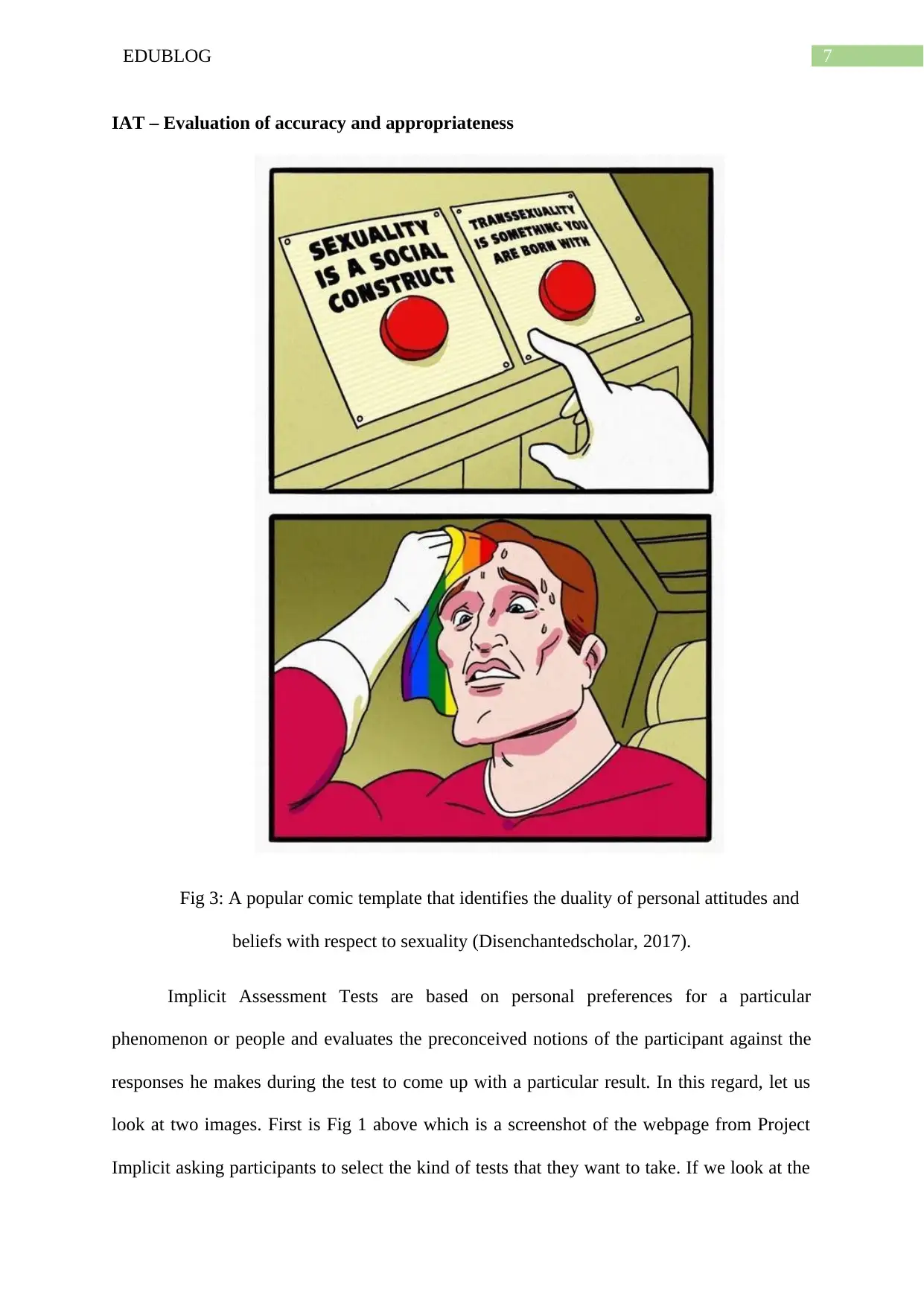
7EDUBLOG
IAT – Evaluation of accuracy and appropriateness
Fig 3: A popular comic template that identifies the duality of personal attitudes and
beliefs with respect to sexuality (Disenchantedscholar, 2017).
Implicit Assessment Tests are based on personal preferences for a particular
phenomenon or people and evaluates the preconceived notions of the participant against the
responses he makes during the test to come up with a particular result. In this regard, let us
look at two images. First is Fig 1 above which is a screenshot of the webpage from Project
Implicit asking participants to select the kind of tests that they want to take. If we look at the
IAT – Evaluation of accuracy and appropriateness
Fig 3: A popular comic template that identifies the duality of personal attitudes and
beliefs with respect to sexuality (Disenchantedscholar, 2017).
Implicit Assessment Tests are based on personal preferences for a particular
phenomenon or people and evaluates the preconceived notions of the participant against the
responses he makes during the test to come up with a particular result. In this regard, let us
look at two images. First is Fig 1 above which is a screenshot of the webpage from Project
Implicit asking participants to select the kind of tests that they want to take. If we look at the

8EDUBLOG
image closely, we see that the categories of tests are more or less concerned with social
phenomena like colourism, religions, association of weapons and violence with a race,
sexuality and gender and even specific aspects like Arab and Muslims as categories. While it
may be difficult to pin point on one particular aspect and evaluate its appropriateness, it is
however possible to examine the test accuracy with a bit of research here and there. At this
juncture, we need to look at the following image (Fig 4).
\
Fig 4: A screenshot of the webpage from Project Implicit informing the participants
about the structure of the test.
This picture is from the selected test category ‘Weapons IAT’. It lets the participants
know that these pictures will be associated together, eventually resulting in associating black
people with harmful objects and white people with harmless, and vice versa. The result of the
test is based on the rate of response according to the picture that is displayed on the screen.
Now, let us look at the following image (Fig 5).
image closely, we see that the categories of tests are more or less concerned with social
phenomena like colourism, religions, association of weapons and violence with a race,
sexuality and gender and even specific aspects like Arab and Muslims as categories. While it
may be difficult to pin point on one particular aspect and evaluate its appropriateness, it is
however possible to examine the test accuracy with a bit of research here and there. At this
juncture, we need to look at the following image (Fig 4).
\
Fig 4: A screenshot of the webpage from Project Implicit informing the participants
about the structure of the test.
This picture is from the selected test category ‘Weapons IAT’. It lets the participants
know that these pictures will be associated together, eventually resulting in associating black
people with harmful objects and white people with harmless, and vice versa. The result of the
test is based on the rate of response according to the picture that is displayed on the screen.
Now, let us look at the following image (Fig 5).
⊘ This is a preview!⊘
Do you want full access?
Subscribe today to unlock all pages.

Trusted by 1+ million students worldwide
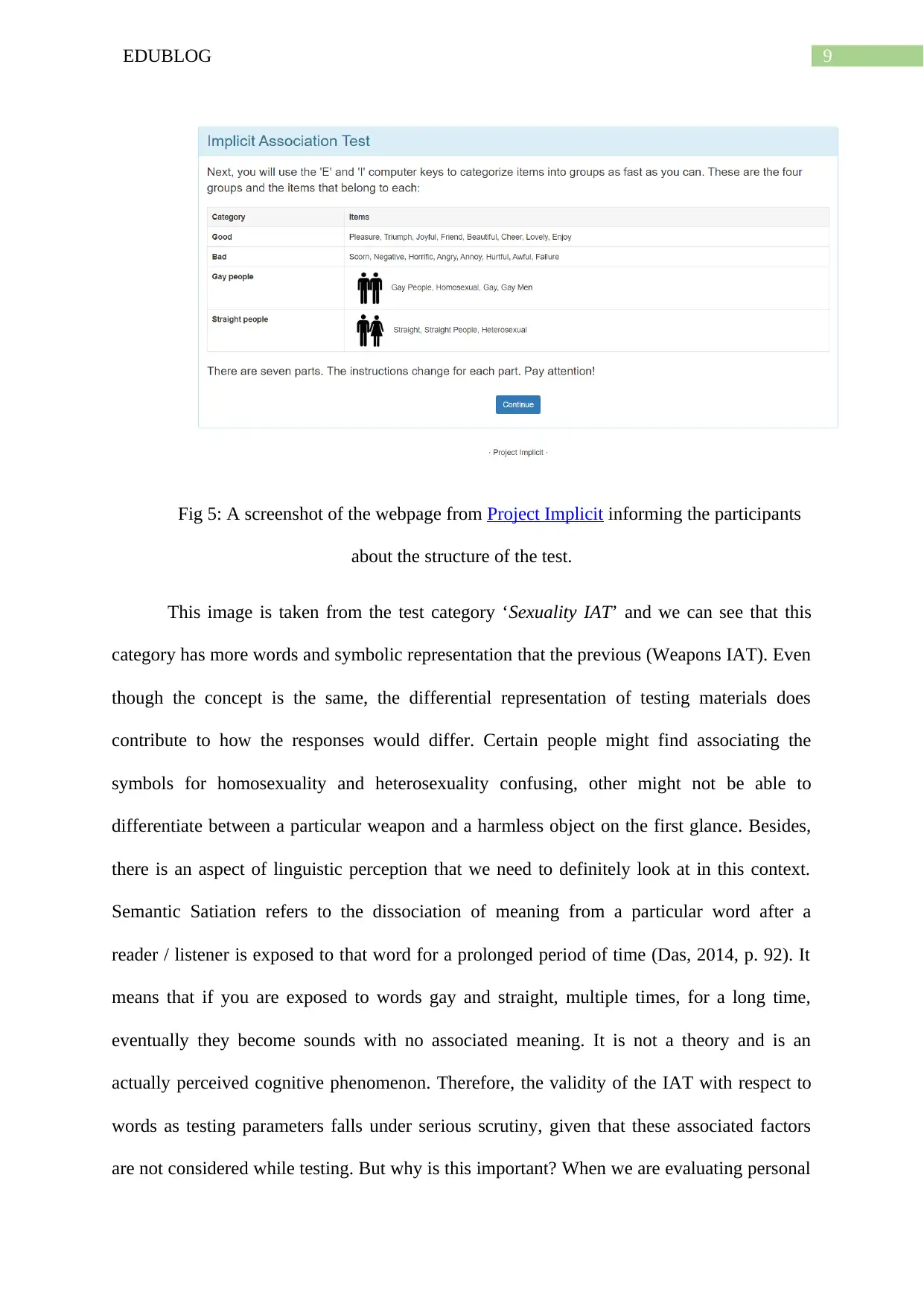
9EDUBLOG
Fig 5: A screenshot of the webpage from Project Implicit informing the participants
about the structure of the test.
This image is taken from the test category ‘Sexuality IAT’ and we can see that this
category has more words and symbolic representation that the previous (Weapons IAT). Even
though the concept is the same, the differential representation of testing materials does
contribute to how the responses would differ. Certain people might find associating the
symbols for homosexuality and heterosexuality confusing, other might not be able to
differentiate between a particular weapon and a harmless object on the first glance. Besides,
there is an aspect of linguistic perception that we need to definitely look at in this context.
Semantic Satiation refers to the dissociation of meaning from a particular word after a
reader / listener is exposed to that word for a prolonged period of time (Das, 2014, p. 92). It
means that if you are exposed to words gay and straight, multiple times, for a long time,
eventually they become sounds with no associated meaning. It is not a theory and is an
actually perceived cognitive phenomenon. Therefore, the validity of the IAT with respect to
words as testing parameters falls under serious scrutiny, given that these associated factors
are not considered while testing. But why is this important? When we are evaluating personal
Fig 5: A screenshot of the webpage from Project Implicit informing the participants
about the structure of the test.
This image is taken from the test category ‘Sexuality IAT’ and we can see that this
category has more words and symbolic representation that the previous (Weapons IAT). Even
though the concept is the same, the differential representation of testing materials does
contribute to how the responses would differ. Certain people might find associating the
symbols for homosexuality and heterosexuality confusing, other might not be able to
differentiate between a particular weapon and a harmless object on the first glance. Besides,
there is an aspect of linguistic perception that we need to definitely look at in this context.
Semantic Satiation refers to the dissociation of meaning from a particular word after a
reader / listener is exposed to that word for a prolonged period of time (Das, 2014, p. 92). It
means that if you are exposed to words gay and straight, multiple times, for a long time,
eventually they become sounds with no associated meaning. It is not a theory and is an
actually perceived cognitive phenomenon. Therefore, the validity of the IAT with respect to
words as testing parameters falls under serious scrutiny, given that these associated factors
are not considered while testing. But why is this important? When we are evaluating personal
Paraphrase This Document
Need a fresh take? Get an instant paraphrase of this document with our AI Paraphraser
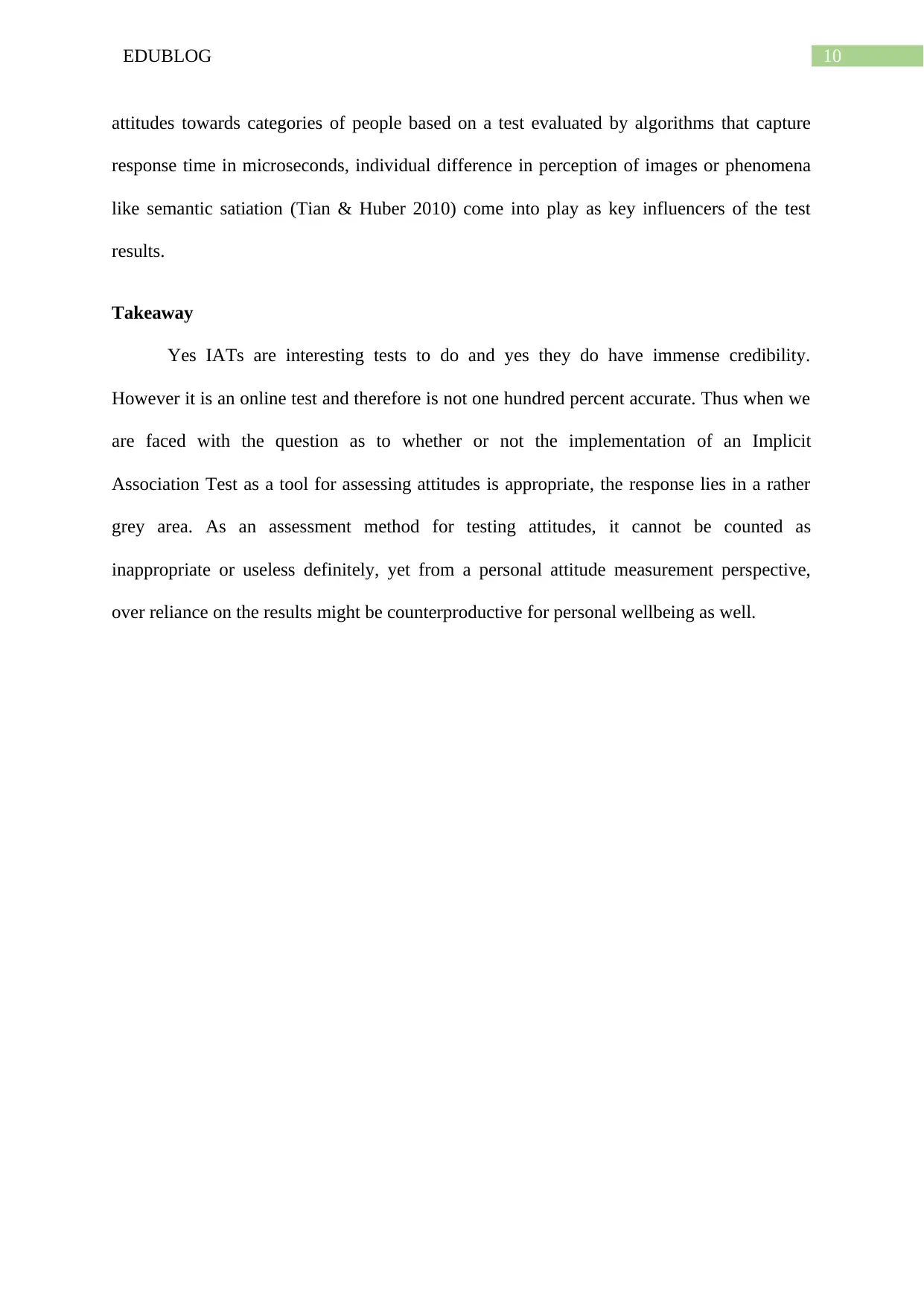
10EDUBLOG
attitudes towards categories of people based on a test evaluated by algorithms that capture
response time in microseconds, individual difference in perception of images or phenomena
like semantic satiation (Tian & Huber 2010) come into play as key influencers of the test
results.
Takeaway
Yes IATs are interesting tests to do and yes they do have immense credibility.
However it is an online test and therefore is not one hundred percent accurate. Thus when we
are faced with the question as to whether or not the implementation of an Implicit
Association Test as a tool for assessing attitudes is appropriate, the response lies in a rather
grey area. As an assessment method for testing attitudes, it cannot be counted as
inappropriate or useless definitely, yet from a personal attitude measurement perspective,
over reliance on the results might be counterproductive for personal wellbeing as well.
attitudes towards categories of people based on a test evaluated by algorithms that capture
response time in microseconds, individual difference in perception of images or phenomena
like semantic satiation (Tian & Huber 2010) come into play as key influencers of the test
results.
Takeaway
Yes IATs are interesting tests to do and yes they do have immense credibility.
However it is an online test and therefore is not one hundred percent accurate. Thus when we
are faced with the question as to whether or not the implementation of an Implicit
Association Test as a tool for assessing attitudes is appropriate, the response lies in a rather
grey area. As an assessment method for testing attitudes, it cannot be counted as
inappropriate or useless definitely, yet from a personal attitude measurement perspective,
over reliance on the results might be counterproductive for personal wellbeing as well.
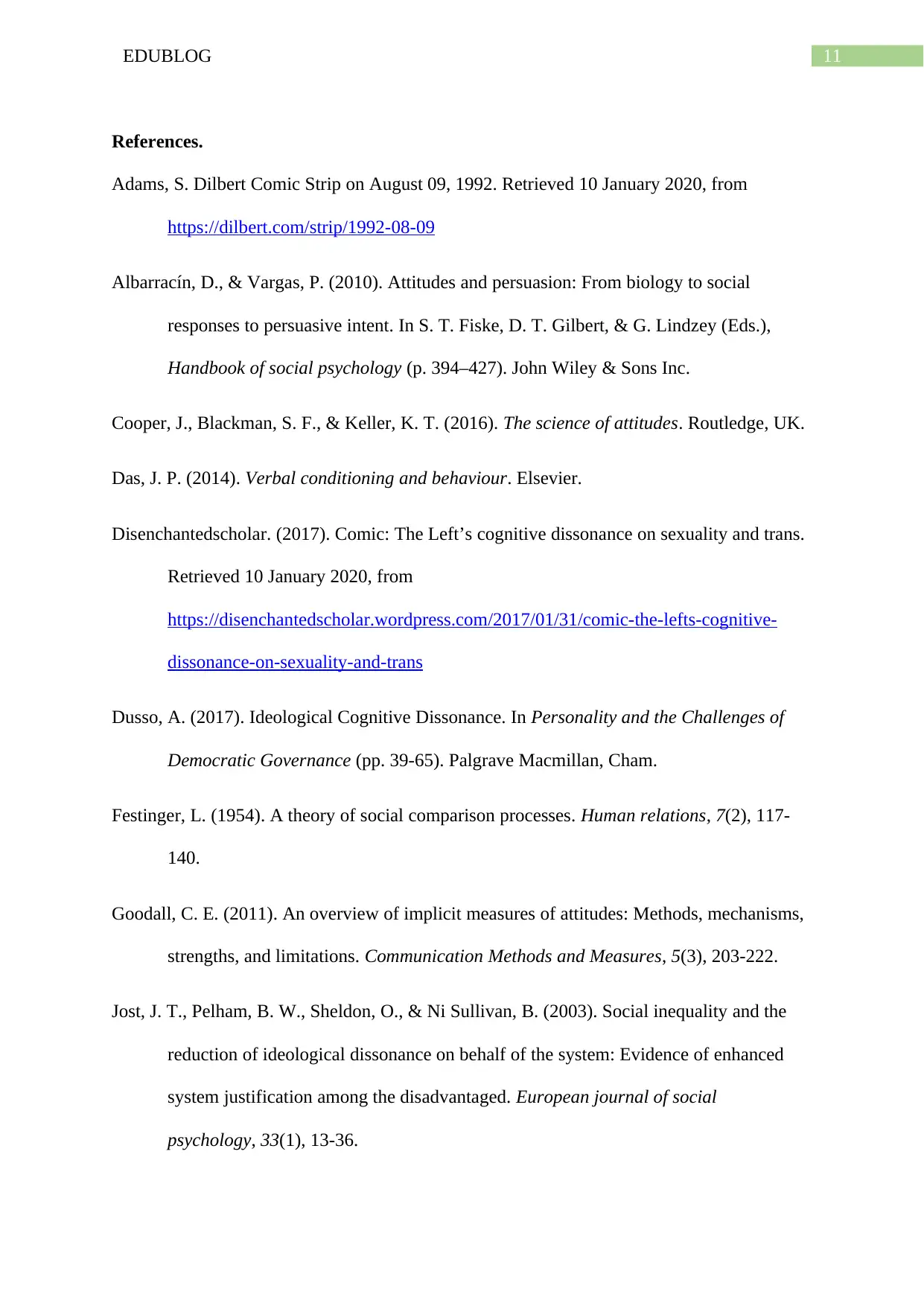
11EDUBLOG
References.
Adams, S. Dilbert Comic Strip on August 09, 1992. Retrieved 10 January 2020, from
https://dilbert.com/strip/1992-08-09
Albarracín, D., & Vargas, P. (2010). Attitudes and persuasion: From biology to social
responses to persuasive intent. In S. T. Fiske, D. T. Gilbert, & G. Lindzey (Eds.),
Handbook of social psychology (p. 394–427). John Wiley & Sons Inc.
Cooper, J., Blackman, S. F., & Keller, K. T. (2016). The science of attitudes. Routledge, UK.
Das, J. P. (2014). Verbal conditioning and behaviour. Elsevier.
Disenchantedscholar. (2017). Comic: The Left’s cognitive dissonance on sexuality and trans.
Retrieved 10 January 2020, from
https://disenchantedscholar.wordpress.com/2017/01/31/comic-the-lefts-cognitive-
dissonance-on-sexuality-and-trans
Dusso, A. (2017). Ideological Cognitive Dissonance. In Personality and the Challenges of
Democratic Governance (pp. 39-65). Palgrave Macmillan, Cham.
Festinger, L. (1954). A theory of social comparison processes. Human relations, 7(2), 117-
140.
Goodall, C. E. (2011). An overview of implicit measures of attitudes: Methods, mechanisms,
strengths, and limitations. Communication Methods and Measures, 5(3), 203-222.
Jost, J. T., Pelham, B. W., Sheldon, O., & Ni Sullivan, B. (2003). Social inequality and the
reduction of ideological dissonance on behalf of the system: Evidence of enhanced
system justification among the disadvantaged. European journal of social
psychology, 33(1), 13-36.
References.
Adams, S. Dilbert Comic Strip on August 09, 1992. Retrieved 10 January 2020, from
https://dilbert.com/strip/1992-08-09
Albarracín, D., & Vargas, P. (2010). Attitudes and persuasion: From biology to social
responses to persuasive intent. In S. T. Fiske, D. T. Gilbert, & G. Lindzey (Eds.),
Handbook of social psychology (p. 394–427). John Wiley & Sons Inc.
Cooper, J., Blackman, S. F., & Keller, K. T. (2016). The science of attitudes. Routledge, UK.
Das, J. P. (2014). Verbal conditioning and behaviour. Elsevier.
Disenchantedscholar. (2017). Comic: The Left’s cognitive dissonance on sexuality and trans.
Retrieved 10 January 2020, from
https://disenchantedscholar.wordpress.com/2017/01/31/comic-the-lefts-cognitive-
dissonance-on-sexuality-and-trans
Dusso, A. (2017). Ideological Cognitive Dissonance. In Personality and the Challenges of
Democratic Governance (pp. 39-65). Palgrave Macmillan, Cham.
Festinger, L. (1954). A theory of social comparison processes. Human relations, 7(2), 117-
140.
Goodall, C. E. (2011). An overview of implicit measures of attitudes: Methods, mechanisms,
strengths, and limitations. Communication Methods and Measures, 5(3), 203-222.
Jost, J. T., Pelham, B. W., Sheldon, O., & Ni Sullivan, B. (2003). Social inequality and the
reduction of ideological dissonance on behalf of the system: Evidence of enhanced
system justification among the disadvantaged. European journal of social
psychology, 33(1), 13-36.
⊘ This is a preview!⊘
Do you want full access?
Subscribe today to unlock all pages.

Trusted by 1+ million students worldwide
1 out of 13
Related Documents
Your All-in-One AI-Powered Toolkit for Academic Success.
+13062052269
info@desklib.com
Available 24*7 on WhatsApp / Email
![[object Object]](/_next/static/media/star-bottom.7253800d.svg)
Unlock your academic potential
Copyright © 2020–2025 A2Z Services. All Rights Reserved. Developed and managed by ZUCOL.





